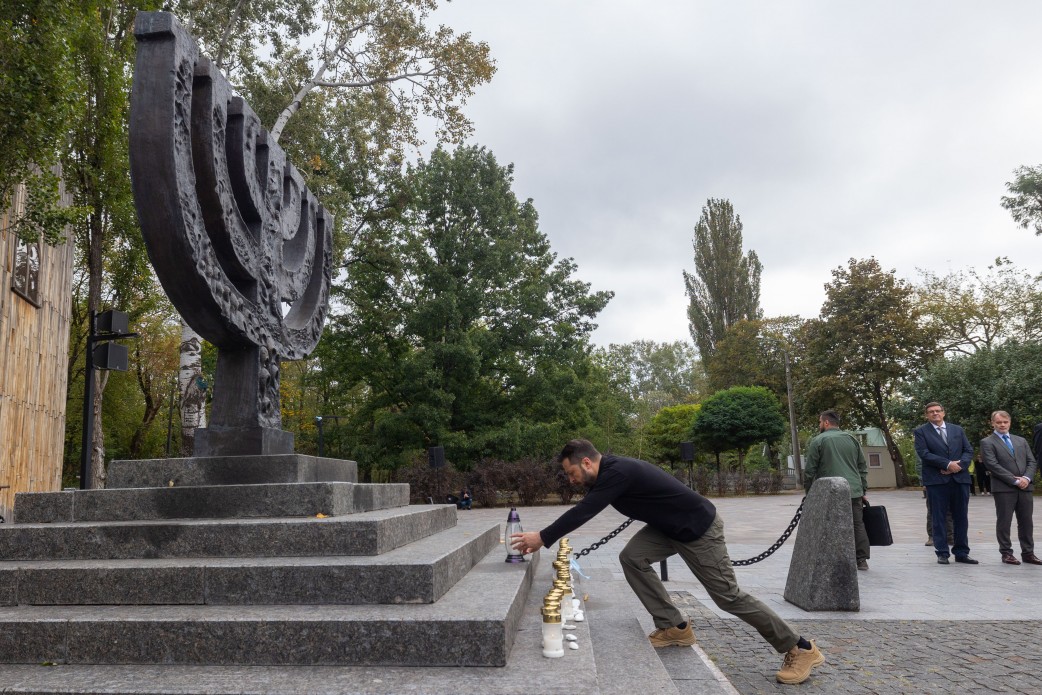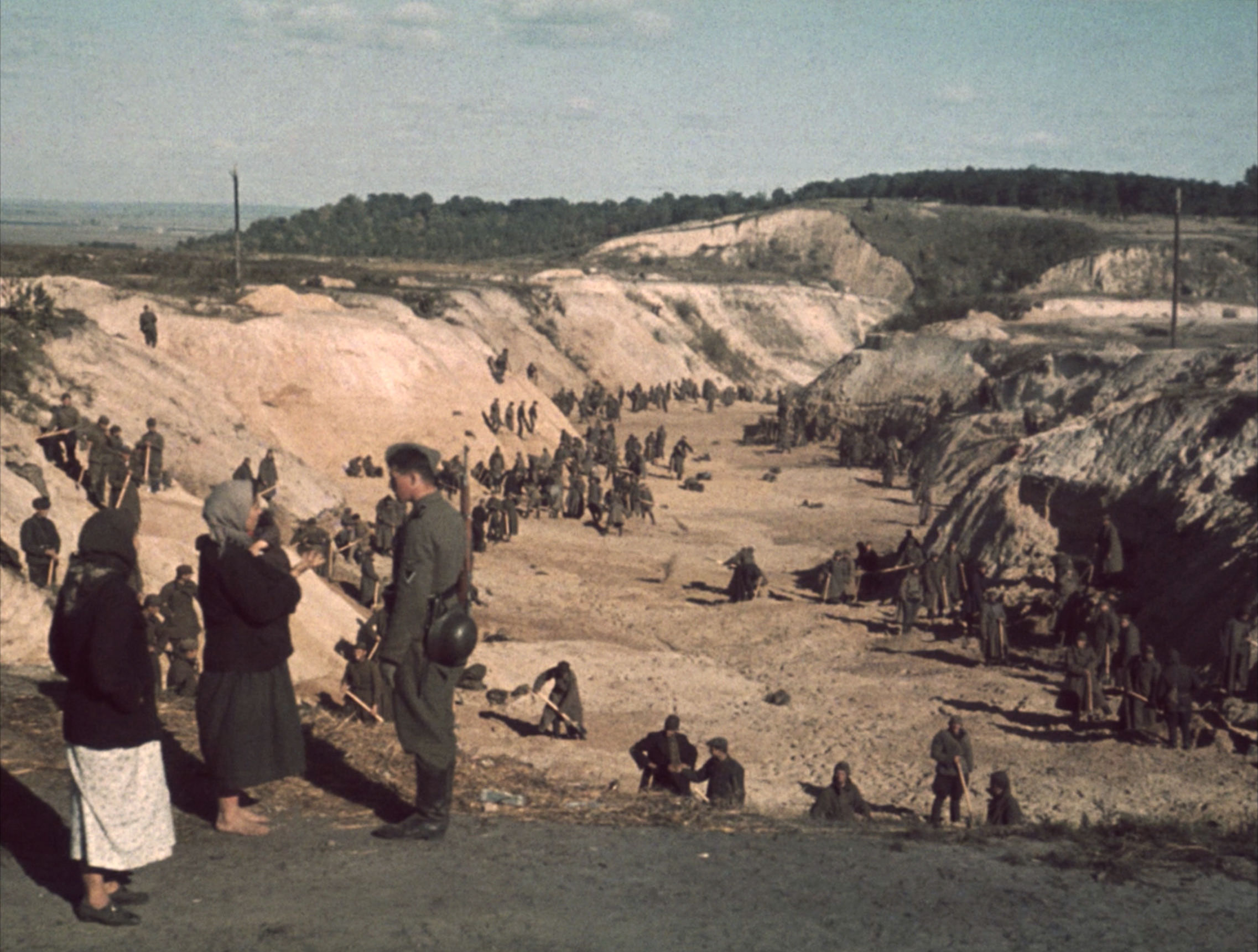In a striking instance of irony stemming from the ongoing Ukraine War, Russia bombarded Ukraine with drones and aerial bombs even as the Ukrainian government observed the 83rd anniversary of Nazi Germany’s Babyn Yar massacre recently.
Commemorating the 83rd anniversary of the Babyn Tragedy, Ukrainian President Volodymyr Zelenskyy paid tribute to the victims of the mass Nazi killings at the Babyn Yar National Historical Memorial Preserve on September 29.
The event was attended by Rabbis, diplomats, Minister of Culture and Strategic Communications Mykola Tochytskyi, Head of the Presidential Office Andriy Yermak, and others. A statement from the Ukraine’s Presidential Office noted that the ceremony honored the memory of the executed Jews and other victims of the Nazis.
The Ukrainian President Volodymyr Zelenskyy wrote on social media site X (formerly Twitter): “Babyn Yar is a terrifying symbol, showing that the most heinous crimes occur when the world chooses to ignore, remain silent, stay indifferent, and lacks the determination to stand up against evil.”
“When the eyes of the world are closed, humanity loses,” the President said in a long post. He further emphasized that the tragedy is an example of the atrocities that regimes are capable of committing when their leaders rely on violence and intimidation.

“But the world’s response should be different. This is the lesson the world should have learned. We must guard humanity, life, and justice. We must defend ourselves against evil,” the President added in the post.
Intriguingly, Zelenskyy’s statement alluded to injustice and crimes against humanity vaguely, even though Nazi Germany was the cause of the Babyn Yar tragedy during World War II. Ukraine has regularly accused Russia of carrying out war crimes.
What Happened At Babyn Yar?
During World War II, Nazi Germany’s forces massacred thousands of people at Babi Yar, also known as Babyn Yar, a ravine in the Ukrainian capital of Kyiv. At that time, Ukraine was a part of the Soviet Union, which was under the leadership of Russia. Babyn Yar is located just outside the Ukrainian capital, Kyiv.
Nazi Germany launched ‘Operation Barbarossa’ by invading the Soviet Union on June 22, 1941. This attack was considered to be the biggest Nazi operation in the war.
Since the operational planning began, German military and police officials planned to launch an annihilation war against the Soviet Union’s “Judeo-Bolshevik” Communist leadership as well as its populace, especially the Jews.
The Einsatzgruppen—mobile units assisting German Police, German security service as well as German intelligence—was tasked to conduct mass shootings of Jews and Communists and just about anybody who was believed to be a threat to German rule over Soviet territory. And so, it began.

German forces invaded Ukraine’s capital city of Kyiv (Kiev) on September 19, 1941, and established an administrative unit called ‘Reichskommissariat Ukraine’.
Before the invasion, about 160,000 Jews were living in Kyiv—comprising almost 20% of the capital’s entire population. However, as Operation Barbossa began in June 1941, approximately 100,000 Jews either left Kyiv or were enlisted in the Soviet armed forces.
Only 60,000 Jews were living in Kyiv at the time when the Nazis arrived. The majority who remained there had either failed or refused to escape. Most of the Jews left behind were women, kids, the elderly, and the sick.
With the help of Einsatzgruppe C members, SS, German police, and their auxiliary groups massacred a large number of the remaining Jewish community in Babyn Yar on September 29 and 30, 1941. The victims were called to the scene, made to strip, and then made to go down into the ravine.
According to reports submitted to the Einsatzgruppen headquarters in Berlin, 33,771 Jews were murdered on those two days.
It began with Nazis pasting notices on walls across Kyiv on September 26, directing the city’s Jewish people to congregate at Babi Yar. The notices were written in Russian, German, and Ukrainian and read: “On September 29, you are to appear by 7:00 am with your possessions, money, documents, valuables, and warm clothing at Dorogozhitshaya Street, next to the Jewish cemetery. Failure to appear is punishable by death.”
The Ukrainian Jews were made to believe that if they gathered in the ravine at the designated time, they would be relocated to a safer location. According to reports, while the Nazis anticipated a gathering of about 5,000-6,000 people, more than 30,000 turned up in the hopes of being taken to safety.
Instead, they were massacred in cold blood.

Due to the size of the gathering, a large number of victims would not have understood what was going on until it was too late. They did not have time to flee when they heard the machine gun fire. Everybody was shot after being driven in groups of ten down a military passageway, according to testimonies presented later.
A truck driver survived and later gave this testimony: “I watched what happened when the Jews – men, women, and children – arrived. The Ukrainians led them past several different places where, one after another, they had to remove their luggage, then their coats, shoes, overgarments, and also underwear… Once undressed, the Jews were led into the ravine, which was about 150 meters long, 30 meters wide, and a good 15 meters deep…When they reached the bottom of the ravine, they were seized by members of the Schultpolizei and made to lie down on top of Jews who had already been shot. That all happened very quickly. The corpses were literally in layers.”
For two years following the September 1941 massacre, the Babyn Yar ravine served as a killing field. German soldiers stationed in Kyiv killed tens of thousands of people, Jews and non-Jews alike. Additionally, Soviet prisoners of war, Roma (Gypsies), and patients from a nearby mental health facility were among the other groups of individuals massacred at Babyn Yar.
The Babyn Yar ravine massacres persisted until the autumn of 1943. They were suspended by Nazi authorities just a few days before the Soviets retook control of Kyiv on November 6, 1943. The overall number of Jews and non-Jews slain at Babyn Yar during the German occupation is believed to have exceeded 100,000.
The tragedy serves as a reminder of the injustice meted out to the Ukrainian Jewish population. Several memorial parks and museums were established by Ukraine in remembrance of the people who lost their lives.
As Russia invaded Ukraine in 2022, Kyiv’s Holocaust memorial was damaged. At that time, the Ukrainian President said in a post on X: ”What is the point of saying ‘never again’ for 80 years if the world stays silent when a bomb drops on the same site of Babyn Yar? At least five killed. History repeating…”
Incidentally, this year’s commemoration coincided with a massive aerial attack by Russia on September 29.
Ukrainian officials stated that multiple guided bombs from Russia struck the Ukrainian city of Zaporizhzhia on September 29, injuring at least 16 people and destroying infrastructure, residential and commercial buildings, and railroads.
Shortly after posting about the Babyn Yar tragedy, Zelensky took to X to post videos of the destruction caused by the Russian bombing.
The President wrote: “This week alone, the Russian army has used nearly 900 aerial bombs, over 300 “Shahed” drones, and more than 40 missiles. This Russian terror knows no pause, and it can only be stopped by the unity of the world—unity in supporting Ukraine and unity in putting pressure on Russia for the war.” He also attached visuals of the mayhem caused by the Russian bombing.
The situation has only become more dire since. Russia announced that its military army had taken complete control of the strategic hilltop town of Vuhledar in eastern Ukraine. Ukraine confirmed the claim as it announced the withdrawal of its forces on October 2.
- Contact the author at sakshi.tiwari9555(at)gmail.com
- Follow EurAsian Times on Google News




